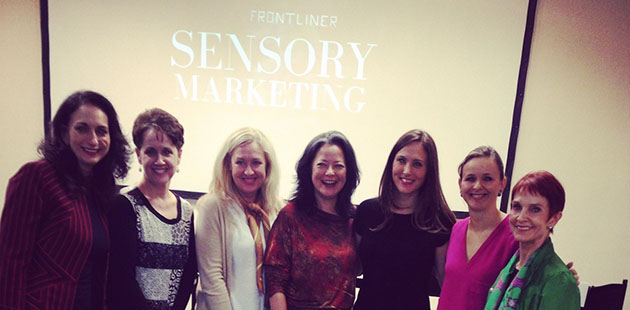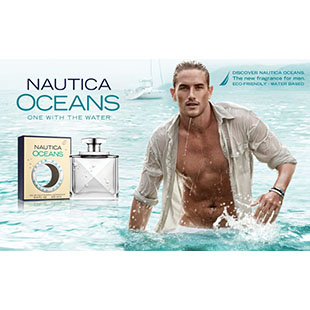
If you've ever walked past an Abercrombie & Fitch or Hollister & Co., you'll know what I mean when I say sensory marketing can be rather powerful.Their signature scents, which are literally sprayed through their stores' ventilation systems, were two of the favorites where I grew up. They had that top-of-mind awareness everyone savored on newly bought A&F or Hollister apparel. The purpose behind what I now think to be a rather excessive tactic is one that defines sensory marketing.
The Fashion Group International hosted a panel discussion on sensory marketing as a part of their Frontliner Series that featured experienced perfumers and marketers, moderated by Caroline Fabrigas, President of Scent Marketing Inc., to share some insights as to how brands stimulate the senses to create an attraction to their products and likeness.
The panel focused on how products effectively connect with senses like sight and smell with color and fragrance. The key idea behind these marketing tactics is the story behind the product or brand.
"A cohesive product story is imperative for a successful product," said Maureen Morrin, Professor of Marketing at Temple University. The story behind a product needs to be clearly delivered, or else consumers will feel the disconnect between the story and the product.
Such a distinguishable distaste for products isn’t always clear, however. How consumers recognize relates to the consumer's senses and feelings. Often, consumers won't exactly know why they don't like the product; they simply know it doesn't meet their expectations because they can't connect with it.
"Consumers also need to feel like smart shoppers," Morrin stated.
This also relates to the product story because, believe it or not, consumers will feel smart when they connect with a sound product and its associated story. Many brand-name companies have taken the initiative in reserving successful components of their sensory-filled story, such as Kelllog, who trademarked the crunch sound familiar in their commercials.
Karen Young, President of the Young Group, reinforced the importance of the story behind a product. A story should incorporate components that will activate as many of the five senses as it can, she said.
"85% of all purchases are emotional, using the right side of the brain; humans connect well to stories," stated Young. In order to create a product story that will connect with the consumer well so that they'll want to purchase the product.
In creating a product story herself, Young outlines 16 characteristics of a scent and rates them on a value  scale alongside definitive vocabulary to appropriately target consumers with her results. These types of studies create products people want, not what they need, "because we don't need 85% of the beauty products we purchase!" Young exclaimed.
scale alongside definitive vocabulary to appropriately target consumers with her results. These types of studies create products people want, not what they need, "because we don't need 85% of the beauty products we purchase!" Young exclaimed.
Ruth Sutcliff, Senior Marketing Director and Fragrance Designer at a global beauty product manufacturer, Coty Inc., provided an excellent example of one Nautica product she had worked on that was backed with a well-rounded story. Nautica, the domestic apparel company, has a name derived from all things related to ships, navigation, or sailors. By incorporating these attributes of Nautica, Sutcliff's team was to create a product package and juice to create an ultimately nautical fragrance. As a part of the nautical theme, the product in its entirety, from juice to package, needed to surround feelings of fresh, clean crystal and pure sea. Additionally, the juice needed to be 100% biodegradable to be associated with eco-friendliness.
"Asking perfumers the biodegradability of their ingredients isn't the most common question or readily answered one at that," said Sutcliff.
Another requirement for the fragrance's juice was that it needed to be a water base as opposed to the more common alcohol base—a difficult find. Many consumers prefer the alcohol-based fragrances because of its lasting quality and how it feels and shimmers on the skin. As they moved forward, the product package color was a shade of blue to represent the ocean. They even integrated an ingredient composed of a head sail that had once traveled all the way around the world and reflected the smell of the sea across the globe—a true homage to the Earth's bodies of water. Sutcliff's illustration exemplifies how intricate the planning process is for such products; it's marketed towards each individual sense that brings the product's story to life.
Color Association Executive Director Leslie Harrington explained the importance color holds in marketing.
"Color is the first sense to be activated," she said. "It has weight and temperature prior to interaction with the object, and so it's effective at a distance."
If you think about road signs, it's clear that it's not only marketers using color to grab your attention and create awareness. Nearly 80% of consumers make purchase decisions based upon color, according to Harrington. There is a connection between the color of a product and the brand attributes of that product; the two have to coincide precisely or consumers will pick up on that disconnection, as with an associated story.
One of Morrin's students is finalizing a study that took place in four Stockholm retail stores. This experiment analyzed daily sales of each retail store against the store's visual displays and consumers' shopping behavior. Depending on the consumers’ sensitivity to messy piles of clothes versus neat folded stacks of clothes, the more sensitive consumers are likely to overlook messy piles of dark clothes as opposed to messy piles of more brightly colored clothes.
Harrington outlined how colors have a strong emotional tie to them. For instance, red is highly associated with fear or love. Harrington stated that primary colors have a better association than secondary colors which only have about a 30-40% correlation accuracy. Although, some secondary colors are close to the shade of a primary color such as orange, which is associated with optimism, as is the primary color yellow.
"Color has universal associations in groups and individually," Harrington said.
As with the mysterious disconnect between a consumer and a product whose story doesn't quite add up, consumers are more apt to associations that don't correlate with a given color than associations that do. Harrington pointed out that each of us have stored every shade of color we've come into contact with.
Fabrigas opened the floor to a question-and-answer session, which was directed to the topic of trend movements in sensory marketing. There is a move towards authenticity of scent marketing, such as a fragrance in a room. Rather than blasting branded fragrances through their stores like Abercrombie & Fitch or Hollister, there needs to be a clear and often more natural origination of the scent to be dispersed throughout the room. The idea is to extract and highlight the organic part of consumers' attraction to a given environment so the scent isn't an imposition. With this kind of sensibility, you are connecting in-depth with consumers and resonating with them.

